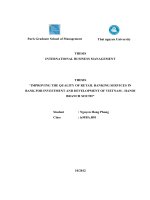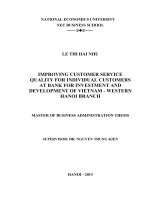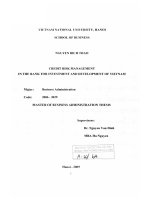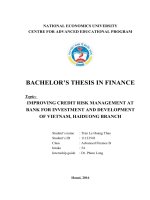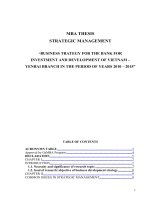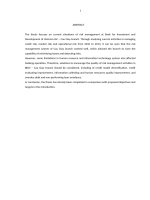IMPROVING CREDIT RISK MANAGEMENT AT BANK FOR INVESTMENT AND DEVELOPMENT OF VIETNAM, HAIDUONG BRANCH
Bạn đang xem bản rút gọn của tài liệu. Xem và tải ngay bản đầy đủ của tài liệu tại đây (378.4 KB, 58 trang )
NATIONAL ECONOMICS UNIVERSITY
CENTRE FOR ADVANCED EDUCATIONAL PROGRAM
BACHELOR’S THESIS IN FINANCE
Topic:
IMPROVING CREDIT RISK MANAGEMENT AT
BANK FOR INVESTMENT AND DEVELOPMENT
OF VIETNAM, HAIDUONG BRANCH
Student’s name
Student’s ID
Class
Intake
Internship guide
: Tran Le Hoang Thao
: 11123543
: Advanced Finance B
: 54
: Dr. Pham Long
2
Supervisor : PhD Pham Long
Tran Le Hoang Thao – AF54B
Hanoi, 2016
Supervisor : PhD Pham Long
Tran Le Hoang Thao – AF54B
i
Supervisor : PhD Pham Long
Tran Le Hoang Thao – AF54B
ACKNOWLEDGEMENT
The internship program is a golden opportunity for learning and selfdevelopment. I myself believe that without the supporting as well as
instructing of so many wonderful people, this report would be impossible to
completion.
Firstly, I would like to sincerely thank for enthusiastic and supports of
Dr. Pham Long during the process of doing this Internship’s thesis.
I would like to thank all of lectures and tutors at National Economic
University in general, and at Advanced Educational Program in particular,
who not only have bestowed their valuable knowledge, hands-on experience
to me, but also have created the favorable opportunities for me to complete
the thesis on time.
Finally, I would like to thank Mr. Nguyen Quy Thang – Deputy manager
of Individual Customer Management Division, and staffs of BIDV Hai Duong
branchfor supporting me during the process that I carried out this report.
Cordially,
Tran Le Hoang Thao
Supervisor : PhD Pham Long
Tran Le Hoang Thao – AF54B
ii
Supervisor : PhD Pham Long
Tran Le Hoang Thao – AF54B
TABLE OF CONTENTS
Supervisor : PhD Pham Long
Tran Le Hoang Thao – AF54B
iii
Supervisor : PhD Pham Long
Tran Le Hoang Thao – AF54B
ABSTRACT
As a student of the Advanced Financial program, with the
desire to learn and reach practical knowledge about commercial
banks, I has come and practiced at BIDV Hai Duong branch in
order to find out the problems that still exists.
During two months of internship in BIDV Hai Duong branch, I
have understood this branch in both organizational structure and its
business activities. Simultaneously, I have a chance to look through
this branch’s collected data from various sources, especially its
financial statement. That brings me a huge support for my thesis
analyzing the branch’s structure, business performance and situation
of credit risk management in the 2013-2015 period. The purpose of
this report is to examine the status of credit risk management at
BIDV Hai Duong Branch. After analyzing the problems, my study
figures out the causes and the solutions to improve the efficiency of
the risk management of credit activities at the branch.
Supervisor : PhD Pham Long
Tran Le Hoang Thao – AF54B
iv
Supervisor : PhD Pham Long
Tran Le Hoang Thao – AF54B
ABBREVIATION
BIDV
: Bank for Investment and Development of Vietnam
CBs
: Commercial banks
PhD
: Doctor of philosophy
SWIFT
: Society for Worldwide Interbank Financial
Telecommunication
NPL
: non-performing loan
Decision QD-NHNN
: Decision of the State Bank of Vietnam
ATM/POS
: Automated teller machine/Point of sale
ISO
: International Organization for Standardization
CIC
: Credit Information Center
HR
: Human Resources
HSC
: Ho Chi Minh City Securities Corporation
Supervisor : PhD Pham Long
Tran Le Hoang Thao – AF54B
v
Supervisor : PhD Pham Long
Tran Le Hoang Thao – AF54B
LIST OF TABLES
LIST OF FIGURES
Supervisor : PhD Pham Long
Tran Le Hoang Thao – AF54B
1
Supervisor : PhD Pham Long
Tran Le Hoang Thao – AF54B
CHAPTER 1: INTRODUCTION
1.1. Research background
1.1.1. Overview of the banking system of Vietnam in 2012-2015
period
Bank credit is one of the most important tools to finance a
nation’seconomy, it contributes to the balanced development of national
industries and other sectors. Bank credit also brings major source of income
for commercial banks. However, bank credit activity contains most of the
serious risks and consequences.
The operation of the banking sector is quite effective with a various of
efforts to upgrade the system and increase quality of management . One of the
important aspects to evaluate the performance of the banking sector is the
ability to control and prevent operational risk, especially risks in credit
activities. Thanks to above efforts ; the credit risk control is now rather
effective with ideal NPL indicators in most of the commercial banks. Those
figures , nevertheless , may not reflect all of potential risks in banking
operations yet. Moreover , being a sensitive sector of the economy , positive
impacts of effective activities of the banking sector on the economy are as
much as negative impacts which occur in case the banking sector is in a poor
performance . Therefore , control and prevention of risks in banking activities
in general and credit risks in particular is a regular , restless job, together with
non-ending research to work out the measures to control and prevent risks
more and more effectively for the local commercial banks that have not-much
experience in the above job . BIDV Hai Duong is among the branches having
quite high credit growth in the banking system . During 2014 , its outstanding
credit grew by 7% and the first eight months of 2015 , this figure was 6% .
Concurrently , incurring of NPLs and overdue debts is also a matter of
Supervisor : PhD Pham Long
Tran Le Hoang Thao – AF54B
2
Supervisor : PhD Pham Long
Tran Le Hoang Thao – AF54B
concern ( BIDV Hai Duong Branch , 2015). So far, there have been many
researches on credit risk of commercial banks, which are somehow
meaningful to the branch in terms of reference resources . Yet, each
individual bank is afftected by different factors determining its success . In
fact , there have been any studies particularly researching on the credit risk
management at BIDV Hai Duong Branch.
1.1.2. Current background of BIDV Hai Duong Branch
BIDV - Hai Duong Branch is one of the most potential banks in Hai
Duong province in recent years. As well as the other banks, its credit rate
grows fastly but the ability of managing credit risk is not effective. As a
result, bad debts were borned and this problem has fluctuated rapidly: in 2013
, the branch’s bad debt ratio was 3% of total loans, then it increased to 7.2%
in 2014, finally in the year 2015 this figure declined to 5% (according to the
final report of BIDV Hai Duong from 2013 to 2015).
Being aware of unforeseen dangers and consequences from the branch’s
problem, I chose the topic : "Improving credit risk management at BIDV Hai
Duong Branch " as subject of my report thesis.
1.2. Research purposes
The general purposes of this thesis are:
- Review the basic theories of credit risk and credit risk management of
commercial banks.
-The factors affecting credit management operations of the branch.
- Analyze status of credit risk management activities at the branch.
- Evaluate the achieved results and operational constraints in credit risk
management at the bank branch.
- Recommend solutions in order to improve credit risk management at
the branch
Supervisor : PhD Pham Long
Tran Le Hoang Thao – AF54B
3
Supervisor : PhD Pham Long
Tran Le Hoang Thao – AF54B
1.3. Research scope
Scope of this research focuses on credit risk management of BIDV Hai
Duong branch in the period 2013 – 2015 and the solutions for the 2016-2020
period. Due to some requirements from the bank about data security, the
annual reports and credit risk documents cannot be publicized. Therefore
some important information has been modified to retain the bank’s
confidentiality.
1.4. Research objectives and methodology
This study focused on credit risk management as a major object and was
conducted using secondary data gathered from BIDV Hai Duong branch’s
financial statements, banking documents and from the writer’s observation
and information taken orally from asking banking officers. These data were
organized and analyzed by the writer, to achieve findings and give out
recommendations.
CHAPTER 2 : LITERATURE REVIEW
2.1. The national researches
Supervisor : PhD Pham Long
Tran Le Hoang Thao – AF54B
4
Supervisor : PhD Pham Long
Tran Le Hoang Thao – AF54B
The problem of credit risk management has received attention from
many different studies. Related to this issue have been some studies, such as:
- Topic: "Strengthening the management of individual credit risk at
Military Commercial Joint Stock Bank", by PhD Nguyen Thanh Son, 2007.
Here the author studies the narrow scope of credit risk management apply to
personal credit. In this study, the author only focused on the study
"Strengthening the management of credit risk", not to mention the "improve
efficiency" of credit risk management.
- Topic: "A number of measures to improve the efficiency of credit
risk management standards and practices in accordance with international
banks", by PhD Tran Thi Bang Tam, 2007. In this thesis, the author
basically focused on "improving the efficiency of credit risk management"
for commercial banks, not the privately analyst at a specific bank. We can
see from this thesis is that the solution is given for raising the efficiency of
credit risk management in accordance with international standards, which
can be applied to each individual commercial banks in each various
locations. However, each bank in each different area will has different
approaches on population characteristics, economic, social and they will
have separately appliance.
- Topic: "Managing credit risk at the Bank for Investment and
Development of Vietnam", by PhD Le Thi Hong Articles, 2008. The
dissertation studied the most common problem to manage credit risk at the
Bank for Investment and Development Vietnam but It did not come up with
effective solutions to improve operational efficiency of credit risk
management at banks.
- Topic: "Improving graded scoring system to minimize customer credit
risk in the banking system of BIDV," Nguyen Phuc – a PhD of Germany, in
Supervisor : PhD Pham Long
Tran Le Hoang Thao – AF54B
5
Supervisor : PhD Pham Long
Tran Le Hoang Thao – AF54B
2008. The thesis has given the measures to improve the system grading
classification system customers at BIDV, very practical significance in the
work of credit risk mitigation. However this is only one of many measures
that can minimize credit risk at banks.
- Topic: "The solutions to control credit risk at the Bank for Investment
and Development of Vietnam - Hai Duong Branch" by PhD Nguyen Thi Thu
Trang, 2010. The author provided basic solutions to control the level of credit
risk but without going into the study of factors affecting the operation of
credit risk management at the bank to take action to improve the system
administrator credit risk at banks.
- Topic: "The solutions to limit credit risk at the Bank for Investment and
Development of Vietnam –
Southern Ha Noi Branch" by PhD Nguyen
Phuong Thao 2011. In this essay, the author just focused in the introduction of
measures to limit credit risk occurs, did not pay attention to the reduction of
losses as well as handling the consequences of the credit risk caused. On the
other hand, the scope of research at BIDV – Southern Hanoi Branch, a
relatively developed province of the capital, Hanoi. The author offered
comprehensive solutions including macro and micro solutions; the solutions
were based on the results of joint assessment on the status of credit risk in
BIDV Southern Hanoi Branch. This is a pretty well written essays, very
valuable reference.
2.2. An overall assessment of the previous theses and the
orientation for my thesis
We can say that the topic of credit risk management is not a new subject,
this subject has had several studies mentioned. However the study that the
author understand the choice of most research on credit risk and credit risk
management for the banking operations but have not come up with solutions
Supervisor : PhD Pham Long
Tran Le Hoang Thao – AF54B
6
Supervisor : PhD Pham Long
Tran Le Hoang Thao – AF54B
that could enhance credit risk management detailedly with the situation of
each branch ; because each branch which operates on different areas will have
different problems that arise in the operation of credit risk management.
Through the surveyed period, to the present time, the author commit
there has never been a research could complete issues credit risk management
at BIDV Hai Duong branch, especially on risk management credit in the
current period, when the economy is going through a difficult period, credit
risk management is the top concern of the leadership team as well as
individual officers of BIDV Hai Duong branch. Therefore, with the theme
"Improving credit risk management at the Bank - Hai Duong Branch", the
author hopes the succeed would come to this thesis , and it could provides
some effective solutions consistent with the operations of BIDV Hai Duong
branch, which can help the bank to enhance credit risk management .
CHAPTER 3 : THEORETICAL BACKGROUND
Supervisor : PhD Pham Long
Tran Le Hoang Thao – AF54B
7
Supervisor : PhD Pham Long
Tran Le Hoang Thao – AF54B
3.1. Credit activities of commercial banks
3.1.1. The definition of a commercial bank
In Vietnam , commercial banks (CB) is known as one of the most
important financial intermediary in the economy. Commercial bank is
financial institution that typically provide diversified financial services with
basic business which is taking deposits, lending and providing payment
services . In addition, CB also offer many other services to satisfy the needs
of the social services.(wiki1)
3.1.2. Definition and characteristics of bank credit
(1) The definition of bank credit
Bank credit is borrowing relation based on the principle of repayment,
in which bank transfers a certain amount of money for customer to use in a
certain period of time according to the agreement,when the maturity comes,
customer must be responsible to pay both capital and interest forthe bank.
Credit activity is the most profitable activity for commercial banks. (wiki2)
(2) Role of credit operations to commercial banks
Apart from the major role of the bank credit to the economy , credit
operation also plays a very important role to every CB. Credit is the basic
activity ,which is crucial for the existence and development of the CB. The
nature of a CB is trading currency. Their activities are mainly ‘borrow to
lend’ . Capital that the bank has raised is used firstly for lending activity and
this is also the most profitable activity of the bank. When the bank does not
maintain and expand credit, the capital the bank raised will be stagnant. The
bank has to pay interest on this amount of capital in the absence of income
from interest. This will lead the bank to incur losses and potentially bankrupt .
Moreover, the quality improvement and credit expansion will enable the bank
to develop more other diversified services. Therefore, the maintenance and
expansion of credit is very important for CB. (Le, 2005,2009)
Supervisor : PhD Pham Long
Tran Le Hoang Thao – AF54B
8
Supervisor : PhD Pham Long
Tran Le Hoang Thao – AF54B
3.1.3. The process of credit
The process of credit includes some steps which have closely
relationship. The main steps are :
Step 1: set up a request document to allocate credit. The bank will
provide necessary information to establish completely loan applications.
Step 2: analyze credit rating. Based on the loan applications, bankstarts
analyzing and evaluating the customers and the loans, and then issues results
by a report.
Step 3: make decision to allocate credit. If the bank agrees to lend,it has
to set up a loan contract. If the bank does not agree to lend ,it has to send
refusal notice to customers.
Step 4: Re-examineloan documents then move to Credit Management
Department to check the legality of the entire record relating to the loans.
Step 5: Start disbursement under the terms agreed in the contract.
Step 6 : Monitoring the loan, ensure that the loan is used for right
purposes.
3.2. Credit risk in commercial banks
3.2.1. The definition of risk and credit risk
Risk is thing that everyone wants to avoid it in all fields of social life.
Risk always exists in business activity andit can be prevented, restricted but
not eliminated entirely.
Credit risk always exists in the operation of commercial banks. Credit
risk will cause serious consequences and financial losses to the bank, in
serious cases,it can lead to bankruptcy. Credit risk is also the most complex
and unavoidable risk management. Therefore, establishing a method of credit
risk management efficiency is always a significant problem .
3.2.2. Credit risk classification
Based on the cause of credit risk, it is divided into the following
categories:
Supervisor : PhD Pham Long
Tran Le Hoang Thao – AF54B
9
Supervisor : PhD Pham Long
Tran Le Hoang Thao – AF54B
- Transaction risk : is a type of credit risk arising from limitations in the
process of transaction , approving loans, assessing customers . Transaction
risk includes selection risk (risks are related to the process of credit
assessment and analysis , borroers’ plans to determine financing of the bank );
guarantee risk (risk arise from guarantee standards such as lending level ,
collateral , guarantee subjects…)
- Operational risk ( risks are related to management of loans and
lending activities , including the use of risk rating systems and techniques
of processing problematic loans) . Porfolio risk is the credit risk arising
from limitations in the loan portfolio management of the bank. It is
classified
into
intrinsic
risk
(risks
derive
from
the
operational
characteristics and the capital use of borrowers ,economic sector) and
centralized risk (risks are because the bank lends too much a small number
of customers , an economic sector or within a certain geographical area or
in a samehigh-risk lending type).
Supervisor : PhD Pham Long
Tran Le Hoang Thao – AF54B
10
Supervisor : PhD Pham Long
Tran Le Hoang Thao – AF54B
Figure 1 : Credit risk classification in commercial banks
(Source : Nguyen , 2013)
If based on objectivity and subjectivity of the cause of the risk , credit
risk is divided into objective risk and subjective risk . Objective risk is the
risk resulting from objective causes such as natural disasters , diseases , the
death and missing of borrowers , and other unexpected changes causing losses
while borrowers have performed the policy seriously . Subject risk is caused
by borrowers and lenders who accidentally or intentionally make loan losses
or by other subjective reasons.
There are also many other kinds of classification such as classification
based on structure of risk types , classification based on the source of risk,
classification based on objects using the loan.
3.2.3. Characteristics of credit risk
- Credit risk is necessary . Credit risk has always existed and associated
with activities of commercial banks ,the bank can limit credit risk to the
lowest level but can not remove it entirely.
- Credit risk is indirect. A bank is an intermediary financial institution
which has an important position in the market economy. It is a currency
trading organization whose primary and regular activities are taking deposits
from customers with accountability of repaying and using that money to lend.
Therefore , when a borrower faces risks in their business such as fire,
flood,war . the partners’ collapse , the boycott of customers to the company’s
products, etc. which leads to a loss or bankruptcy , it will indirectly influence
on commercial banks. So, credit risk is indirect.
- Credit risk is diverse and complex . The diversity of credit risk can be
characterized by several types : moral risk , mechanism risk , inspecton and
control risk , etc. (Nguyen, 2013)
Supervisor : PhD Pham Long
Tran Le Hoang Thao – AF54B
11
Supervisor : PhD Pham Long
Tran Le Hoang Thao – AF54B
3.2.4. Causes of credit risk
There are many causes of credit risk,itcan be divided into two main
causes, they are subjective and objective causes. Risks due to objective
reasons is credit risk comes from the business environment. Risks due to
subjective reasons is the risk comes from the borrower and lender.
(1) The subjective reasons
- Causes from the bank :
• Due to unprofessional skills and badly morality ofofficers. The low
level of job performance will impact significantly on the quality of the loans,
which leads to credit risk.
• Due to credit policies of the banks are unclear. A science-based credit
policy is outlined in strategy of the bank. Credit policy which is unclear and
inconsistent with the strategies will lead to credit risk.
• The untight inspection, internal controls and after-lending management
will lead to credit risk. Internal control system plays an important role in
determining the success or failure of a bank, but in fact it has not been
properly concerned in many banks
• Bank do not concern risk management but run under its revenue. To
expand credit and increase revenue, many banks has eased regulations on
lending. It may lead to credit risk.
- Causes from borrowers :
Because individual and enterprise customers often lack of experience in
financial management ,lack of own capital , hence, when they meet the
competition from other competitive enterprises , they will surfer losses. As a
result, they will not be able to pay the debts for the lenders.
If the customers use other funds for the purpose which was not given in
Supervisor : PhD Pham Long
Tran Le Hoang Thao – AF54B
12
Supervisor : PhD Pham Long
Tran Le Hoang Thao – AF54B
the credit agreement, it will lead to overdue loans.
In the case that customers usethe loans as capital turnover for other
purposes instead of repaying for the bank, credit risk will appear.
(2) The objective reasons :
Due to impact of the economic environment. If the economy is
deteriorated, enterprises can not make profit and they will not be able to
payloans.
Due to the regulatory environment. The change in the economic
mechanisms and policies can put the enterprise in a difficult position in
economic market,it leads to the bank’s damage in credit activity.
Due to natural conditions: when some natural disasters such as
earthquakes, floods, storms ... come, it may cause seriously damage to
operation of enterprises and banks, it will have influence on the customers’
ability of repayingloans.
3.2.5. The consequences of the credit risk
Credit activity of CBs is related to many different sectors of the
economy. Therefore, the occurrence of credit risk will have consequences for
commercial banks, customers and the entire economy.
* For commercial banks :
- Credit risks affect to the solvency of the bank. Credit risk occurs will
make the bank can not collect the principal and interest on time as committed
in the credit agreement, and make the bank reduce the speed’s rotation of
capital and its solvency. Besides, the bank has to pay capital and interest on
time deposits, which makes the bank could fall into a loss of liquidity.
- Credit risks affect to the bank's reputation. A bank with a high credit
risk would stand in danger of losing credibility in the market, reducing the
competitiveness of the bank. Once customers lose the trust of business
Supervisor : PhD Pham Long
Tran Le Hoang Thao – AF54B
13
Supervisor : PhD Pham Long
Tran Le Hoang Thao – AF54B
partners , the bank will lose market share in all aspects , banking operations
will fall into the predicament. Be very dangerous especially if this case
happens: the depositors simultaneously withdraw money due to lose
confidence in the bank, this problem can make the bank bankrupt.
- Credit risks can reduce the profitability of the bank. If credit risks can
not collect principal and interest on time , the bank's income from credit
activity will decrease. At the same time when the risks occur, it will rise to
overdue debts, bad debts ,and banks will have to spend the expenses for
managing, monitoring, collecting debts, processing costs of collateral. On the
other hand, credit risks occur also has impacts on other business activities of
the banks, curbing the activities of the bank, reducing profits and affecting
bank’s financial situation .
* For customers :
- For depositors : when the bank faces to credit risks, and fails to recover
principal and interest on the loans, the bank’s reputation
may decline,
depositors may lose confidence in the bank, they will simultaneously
withdraw all of their money from the bank, therefore, the bank will lose its
liquidity. Meanwhile depositors will not be able to withdraw the funds which
were sent to the bank anymore.
- For customers who borrow money: Due to declining funds mobilized
,the bank will have to narrow down the outstanding credit. Borrowers will get
more difficulties to getting a loan from the bank.
- For customers caused bad debts and overdue debts to the bank : they
will be subject to higher interest rates in term of interest rates, causing huge
financial pressure on the customers. At the same time, due to lost credibility,
customers will encounter more difficulties to accessing new capital.
* For the economy :
Supervisor : PhD Pham Long
Tran Le Hoang Thao – AF54B
14
Supervisor : PhD Pham Long
Tran Le Hoang Thao – AF54B
Banking activities related to the operation of the entire economy. When
credit risk occurs,it leads to bankruptcy and affects many other banks in the
economy. The collapse of a bank can trigger the collapse of the entire banking
system, causing loss of confidence in the people, leading to stagnation of
production and business, economic crisis.
3.3. Credit risk management at commercial banks
3.3.1. Definition of credit risk management at CBs
As mentioned above, in banking operations, credit activities account for
a major proportion. The total loans outstanding accounts for more than half of
the total assets of the bank ; income from credit accounts for about ½ to 2/3 of
the bank earnings (Nguyen, 2006) . Credit activities always hold potential
risks resulting from the fact that the bank has a bad credit risk management
policy and loose management; and is not transparent in granting credits.
Therefore, credit risk management is of the priorities and the most
important task in the bank management process. It must be done regularly ,
continuosly, seriously and thoroughly. Generally, credit risk management
can be seen as measuring the risk level , suggesting risk management
methods, controlling and reporting risks , and performing risk prevention
measures ( Phan & Dam, 2007).
3.3.2. Contents of credit risk management
(1) Identify credit risk
Banks should have methods to recognize signs of credit risk to refuse
lending (in the case before lending) or to prevent timely (in the case after
lending). Signs of credit risk can be divided into following groups :
- Group of signs related to the bank’s relationship :
• Over a period of time, customers’ accounts tend to be difficult in
payroll; decline in account balances;
Supervisor : PhD Pham Long
requestsfrequentlyfor assistance in
Tran Le Hoang Thao – AF54B
15
Supervisor : PhD Pham Long
Tran Le Hoang Thao – AF54B
liquid capital from various sources .
• The loan operations: late payment of principal and interest; loan
requests exceed expected demand.
-Group of signs related to technique and trade
• Customer has difficulty in product development.
• Changes in the market: the exchange rate, interest rates, consuming
tastes, new technologies, added competition.
• Change from the state policy: tax policy, the conditions for
establishment and operation.
• Customer's product is highly seasonal.
- The non-financial signs: ethical issues and appearance of customer ;
degradation of the enterprise’s infrastructure
(2) Methods to measure credit risks :
After indentifying credit risks,the banks should consider the level of risk
to help the Executive Board determine the risk which should be monitored
and controlled. Credit risks can be measured by several methods:
- Determine the credit limit for each specific borrower : credit limits
show the maximum quantitative of credit risks that the bank may accept. To
limit the potential risks, the banks should offer lower credit limits for new
customer relationships, and must regularly review credit limits to customers
during establish the credit relations.
- Apply the scoring method of credit risk: this is a relatively scientific
measure when quantifying risks. It bases on the operational status and
characteristics of credits in the past, to predict credit operations which have
similar characteristics in the future. Credit officers can evaluate the level of
risks and rate the borrower groups through the scoring system
- Make standby provision for credit risks: this method estimates credit
Supervisor : PhD Pham Long
Tran Le Hoang Thao – AF54B
16
Supervisor : PhD Pham Long
Tran Le Hoang Thao – AF54B
losses on total current loan portfolio. Banks should have an appropriate
internal rating system to give the correct evaluation.
In summary, depending on ability and the specific conditions of each
bank ,we will apply the suitable method .
3.4. Factors affect to the credit risk management
3.4.1. Subjective factor
The subjective factor is the factor derived from the bank itself, it is the
most important factor in determining the level of credit risk management.
These factors include:
- Organizational structure of the bank. The bank which has the scientific
organizational structure creates a reasonable wayto reach the highest
efficiency in credit risk management.
- Credit policy and creditprocess of the bank: Through credit policy , the
bank can achieve a diversified credit portfolio, increase profitability and
control potential risks. If the credit policy is inefficiency,it will cause
difficulties for the risk management and the possibility of credit risk will be
much higher. A bank has a reasonable credit process will contribute to
improve credit quality and minimize credit risk .
3.4.2. Objective factors
Some objective factors which affect the operation of credit risk
management can be mentioned are : customer factor, information
environment factor, legal environment factor , natural environment and social
economy factor.
- Customer factor : credit activity is offerred to serve customers, so the
bank can not restrict credit by itself, but the bank needs cooperation from the
customers. The customer is a key factor affecting measures of credit risk
management. The key factors are :
Supervisor : PhD Pham Long
Tran Le Hoang Thao – AF54B
17
Supervisor : PhD Pham Long
Tran Le Hoang Thao – AF54B
• Management capacity, production and business situation, financial
situation of the customers.
• The customers’ behavior : If the customers have bad behavior or they
do not use credit for the right purpose, they can make the measures of credit
risk management become useless.
- Information environment factor : due to the limitation of accuracy,
transparency and reliability of information which are provided by legal
agencies , it will be difficult to find out exactly information of customers for
the bank.
-Legal environment factor : (economy, politic, culture, society)
• Banking activities are influenced by many legal environmental factors .
A good legal environment will contribute positively to the effectiveness of
measures to manage credit risk.
•The factors relates to financial disasters such asinflation, exchange
rates, recession, ...can affect directly and indirectly to payment ability of the
borrowers,.
• The factors relates to the natural environment such as flood, fire,
diseases, ... may affect to the production,it will make banks can not carry out
the measures of management credit risk.
3.5. Experience of credit risk management at commercial banks in
several countries around the world, lessons for banks in Vietnam.
3.5.1. Experience of credit risk management at commercial banks in
several countries around the world
Foreign banks consider risk management as one of the long-term
strategy carried out at many levels. To reduce risks in operations, these banks
employ the following methods: hiring consulting companies to support risk
management; establishing a council for handling risks, emphasizing on human
Supervisor : PhD Pham Long
Tran Le Hoang Thao – AF54B
18
Supervisor : PhD Pham Long
Tran Le Hoang Thao – AF54B
and risk management system.
Nguyen (2006) suggested that credit risk management in these banks
focuses on solving the following issues: Credit policy, three basic tasks of
The Risk Handling Council, and Managing risks. Credit policy : This is a
most general rule governing all credit activities, guiding and directing the
overall credit operations. The Risk Handling Council has three basic tasks:
Deciding common problems of risk and risk management; Controlling the
credit extension for large accounts, identifying investment portfolio; Updating
and modifying credit policies, customer policies in accordance with changes
in economic, political and social situations of a region, a sector, or a country.
Managing risks is by giving a mechanism of self-controling, evaluating, then
measuring risks and determining the management mechanism for each unit.
Concurrently, the Basel II program is implemented strictly with the
recommended standards.
3.5.2. Lessons for CBs in Vietnam
Through the experience of other CBs in some countries, we can infer
several lessons for CBs in Vietnam :
- Experts in credit risk management should be often trained. The bank
should organize training courses for staffs to improve their competence in
credit risk management.
- Enhance inspection and internal control to prevent risks.
- Pay attention to develop information technology systems to serve the
analysis, evaluation and measurement of credit risk to warn about the
unforeseen .
- Establish relationships with the insurance organizations or loan trading
organizations
- Diversify the portfolio and customer to disperse credit risks.
Supervisor : PhD Pham Long
Tran Le Hoang Thao – AF54B
